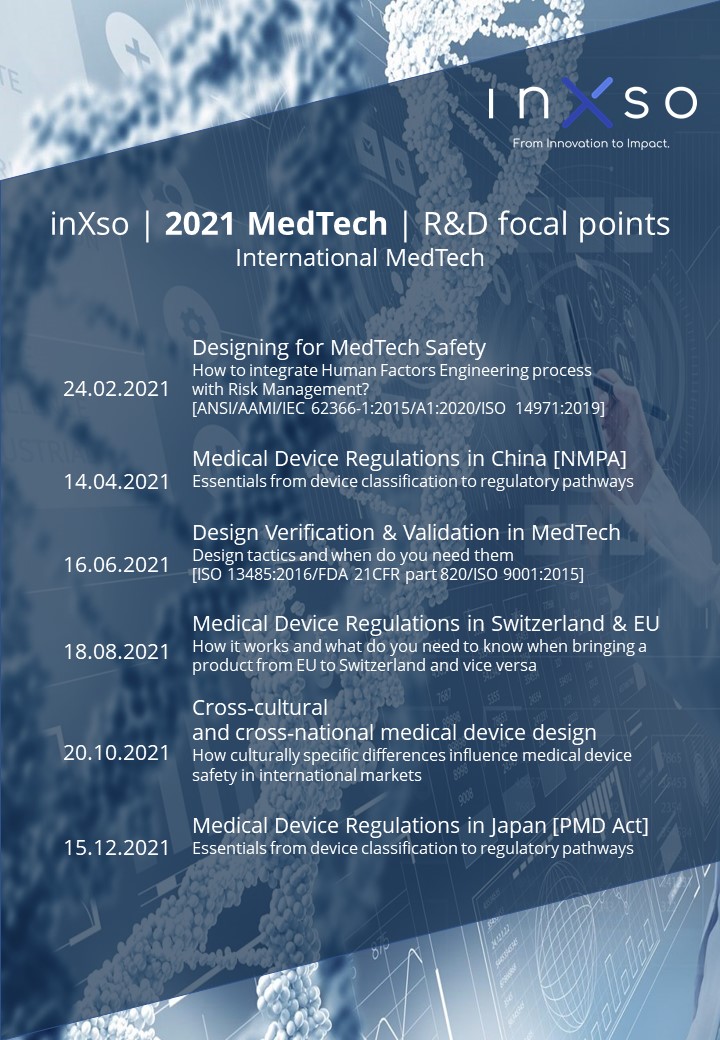Free introductory webinar series focusing on MedTech R&D
For 2021, inXso has created a series of webinars “inXso 2021 MedTech Series R&D focal points”, outlining some of the specificities relevant to the global design of medical technologies. Half of the series will cover some regulatory considerations in the context of the EU MDR and Swiss regulatory environments, as well as some basic regulatory features of China and Japan that any company considering these healthcare markets should be familiar with.
The schedule spans through the year 2021, with a total of six sessions, one every two months. Three of these will focus on development issues and three on regulatory aspects:
Six 45min lectures + 15min question round1 in every two months through the year 2021 (check schedule)
Introducing Japanese and Chinese regulatory requirements and essentials
How do the medical device regulations work between Switzerland and the EU
Human Factors Engineering process in international design integrated with Risk Management
Design V&V in an aligned cross-national regulatory framework
Cross-cultural and cross-national design – what do you need to consider?
Registration via link on the left panel

Schedule for inXso 2021 MedTech Series | R&D Focal Points
What are inXso 2021 MedTech Series R&D focal points about?
Here are more details about each session, including what the sessions will focus on and what insights you can gain.
First session: 24.02.2021
Designing for MedTech Safety
Focuses on how to integrate Human Factors Engineering (HFE) process with Risk Management according to standards [ANSI/AAMI/IEC 62366-1:2015/A1:2020/ISO 14971:2019]
This is an important factor in safe-by-design as user error is a significant factor in thousands of adverse events leading to patient injuries and deaths annually, and such use errors may happen by mistake by healthcare professionals and patients alike.
One of the root causes is the poor human factors design, and HFE and Usability Engineering have been identified as particularly important aspects of the risk management plan for medical device safety.
Unfortunately, many developers make the mistake of trying to conduct a human factors validation study – while skipping the formative study – at the last moment because it is required for regulatory approval.
Through this session, we will also take a very quick look at user research, the framework of the factors in cross-cultural and cross-national design, user-centered design, and how to align risk management, HFE, and product development along with other features for safe and effective design.
Second session: 14.04.2021
Medical Device Regulations in China [NMPA]
Essentials from device classification to regulatory pathways as the Chinese regulatory landscape is vastly different compared to other major markets. The most used description is „everchanging“, for which one reason is that in 2013 China joined the International Medical Device Regulators Forum (IMDRF) with the purpose of integrating into the international regulatory landscape. In practice, this meant the complete „Overhaul“ of regulations in 2014, which were revised again in 2017. For regulators, this means that finding the exact indications that meet the NMPA requirements can be time-consuming and quite difficult. It is also noteworthy that behind all plays the role of the old Soviet Union legislation that makes the modern Chinese legislation quite interpretative.
Through this session, we will share practical hints, take a look at fast-track and custom medical device pathways, and on how to keep track of regulatory changes. Included is also a very quick take on quality management, standards, and specifications, electronic approval, unique device identification (UDI) system as well as market authorization holder (MAH) system.
Third session: 16.06.2021
Design Verification & Validation in MedTech
Focuses on design tactics and how to use them in design V&V to ensure safe-by-design, which is important because guidance by regulatory authorities describes what must be done, but not how you should do it. Moreover, if requirements capture, design, and testing are not done appropriately, this could lead to serious design errors which in turn leads to patient or end user hazards.
In this context, we take a quick look at a comparison of [ISO 13485:2016/FDA 21CFR part 820/ISO 9001:2015] standards and their effect on design V&V procedures depending on the target market regulatory landscape.
Alongside this, we will scrape through other aspects affecting design V&V, such as design controls, user-centered design, requirement capture, and Design of Experiments (DoE) that lie under the basics of Design V&V testing.
Fourth session: 18.08.2021 -> Rescheduled to 25.08.2021
Medical Device Regulations in Switzerland & EU
Focuses on how regulatory affairs work between the EU and Switzerland and what you need to know when bringing a product from the EU to Switzerland and vice versa.
Since 2001, Switzerland has regulated medical devices in the same way as the EU and has been integrated into the European market surveillance system and European internal market for medical devices via the Mutual Recognition Agreement (MRA). This means that medical devices did not undergo an official authorization procedure, as Switzerland had taken over the European Union (EU) system of compliance assessment and certification. This had been based on bilateral agreements. However, medicinal products, such as therapeutics, and pharmaceuticals, still needed to be officially authorized to enter the Swiss market.
However, from the Date of Application of the EU Medical Devices Regulation (MDR) on 26th May 2021, the lack of an updated MRA has affected the mutual market access and trading of:
- Medical devices
- Coordinated market surveillance activities
- Sharing of information between authorities
- or the mutual recognition of certificates of conformity
From the Swiss perspective, the Swiss manufacturers must appoint an EU-based Authorized Representative (AR) and/or importer in line with Article 11 and Article 13 of the MDR. On the other hand, non-EU manufacturers relying on a Swiss Authorized Representative (AR) and/or importer, must appoint an EU-based Authorized Representative (AR) and/or importer in line with Article 11 and Article 13 of the MDR. As of May 26th, 2021, export certificates (FSC) for medical devices are issued only according to the new law, as it is no longer possible to issue export certificates (FSC) according to the old law.
From the EU perspective, medical devices placed on the EU market must now formally be placed on the market in Switzerland, in compliance with Swiss law. The authority to turn to is MedDO, which introduces the MDR requirements in Switzerland. This covers only Switzerland and not the EU or EEA. This requires non-Swiss manufacturers to mandate an Authorized Representative (AR) in line with Article 51 and have their devices placed on the market by a Swiss importer in line with Article 53.
The regulatory landscape will continue to change between Switzerland and the EU in the future, so keep on track on the official sites.
Fifth session: 20.10.2021
Cross-cultural and cross-national medical device design
Will take a deeper look at how culturally specific differences influence medical device safety in international markets.
Cross-cultural and cross-national medical device design refers to the medical device design for international markets, where the design requirements address culturally specific differences that may influence the safety of medical devices in other countries. Cross-cultural and cross-national design requirements have to be met during the Human Factors Engineering (HFE), usability IEC 62366, and risk management ISO 14971 process, as failure to do so may violate these international standards. Culture-specific design is also an important business issue; users are more prone to buy products that address their culturally related requirements and expectations, which also becomes a marketing value.
This is important because identifying culture- and nation-influenced design factors enhance the user safety and user experience of the end-user, but also aims to meet the needs of several markets (e.g. European, Asian, and North American) simultaneously. A globalized medical device will meet the needs of all targeted market segments, with fewer cultural differences – varied user groups leading to global characteristics. Despite the increased awareness, medical devices are usually designed for one specific target market, and the route to internationalize is via localization.
We will also take a look at design considerations for specific cultural and national differences, key challenges, regulatory issues, technical environment, and microenvironmental characteristics but also social, work, and professional context without forgetting anthropometric characteristics among others.
Sixth session: 15.12.2021
Medical Device Regulations in Japan [PMD Act]
Will take a deeper look at the complex Japanese regulatory system while providing essentials from device classification to regulatory pathways.
We will browse through the essential authorities, such as the Pharmaceuticals and Medical Devices Agency (PMDA), the Japanese regulatory agency that Works under the Ministry of Health, Labour and Welfare (Regulatory Authority) and is responsible for ensuring the safety, efficacy, and quality of pharmaceuticals, medical devices, regenerative medical products, cellular and gene therapy products, cosmetics, reviewing scientific publications, post-market surveillance, adverse events report/relief compensation and development of regulatory affairs and standards.
Ministry of Health, Labour and Welfare (MHLW) is the acting regulatory authority that monitors PMDA, promotes innovations in the pharmaceutical and medical device industries, and ensures pharmaceutical and food safety. its responsibilities are also registration of (foreign) manufacturers, enacting guidelines, industry standards, and ministerial ordinances, as well as licensing of; Marketing Authorization Holders (MAH), distributors, service providers, etc.
We will also scrape through authorization procedures, clinical evaluation, certification database, quality management system (Japanese requirements), reimbursement policy by National Health Insurance (NHI), and its six product classes A1, A2, B, C1, C2, and F. Alongside we will take a quick look at Market Authorization Holder (MAH) and Designated Market Authorization Holder (D-MAH) requirements, as well as a foreign manufacturer registration system and post-market safety issues among others.

